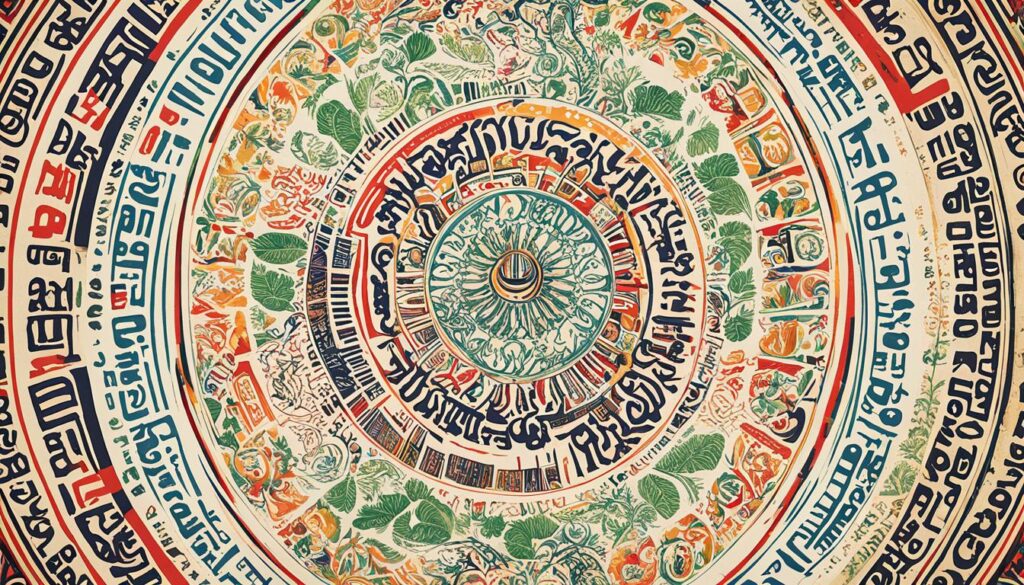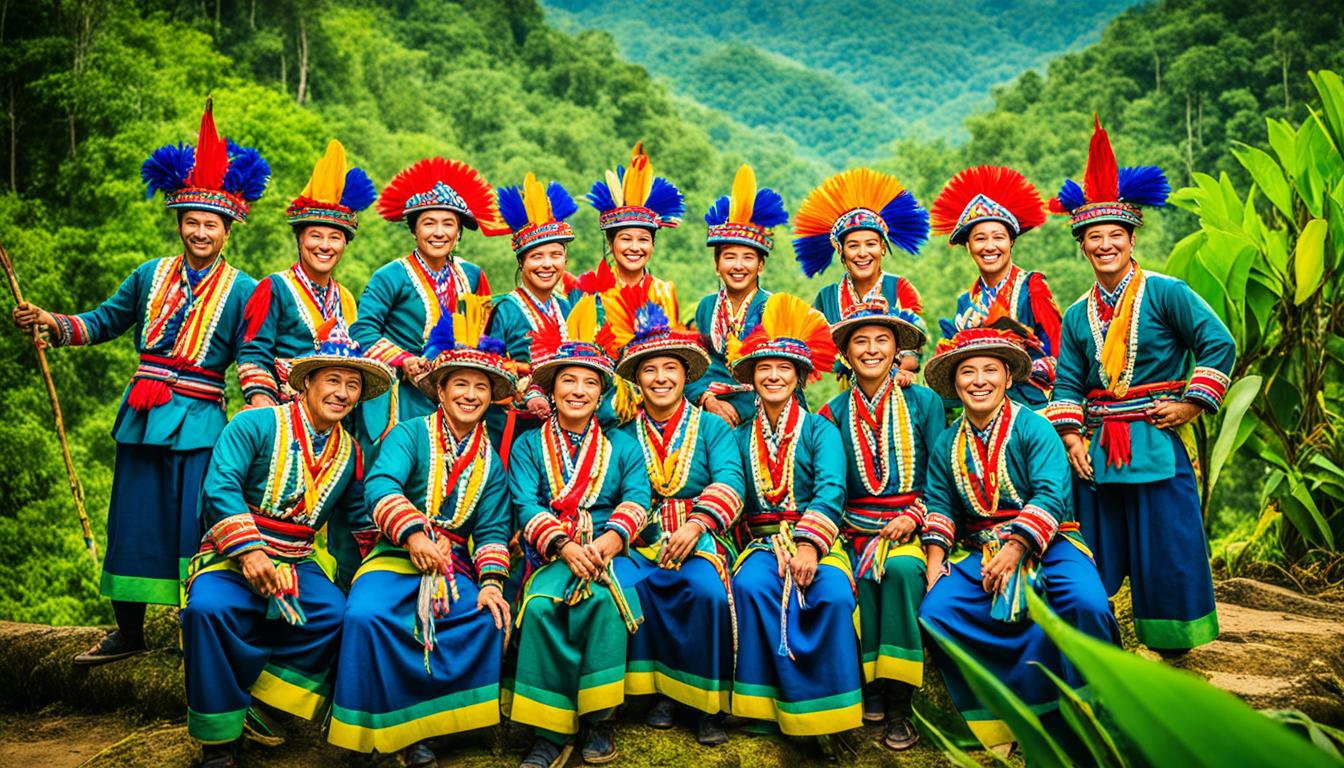Did you know that the Khmu people, with a population of around 800,000, are an ethnic group in Southeast Asia primarily living in northern Laos? They also have communities in Vietnam, Thailand, China, and diaspora populations in the United States. The Khmu have a rich cultural heritage and are known for their unique language, which belongs to the Austroasiatic language family. They have their own dialects, traditions, and customs that set them apart from other ethnic groups in the region.
History and Origins of the Khmu People
The Khmu people have a long and fascinating history that can be traced back to their origins in China. Over time, they embarked on a migratory journey, ultimately settling in parts of Laos, Vietnam, Thailand, and China. Today, the Khmu are considered one of the largest ethnic minorities in northern Laos, with a distinct tribal identity and a rich cultural heritage.
This migration played a crucial role in shaping the Khmu tribe and their unique traditions. As they adapted to their new environments, the Khmu people preserved their distinctive culture, which is heavily influenced by their agricultural way of life. Their traditions are deeply interconnected with the land, reflecting their close relationship with nature and reliance on farming.
“The Khmu people have a long and fascinating history that can be traced back to their origins in China. Over time, they embarked on a migratory journey, ultimately settling in parts of Laos, Vietnam, Thailand, and China.”
The Khmu tribe’s history is a testament to their resilience and adaptability. Despite the challenges of migration and cultural change, they have managed to maintain their unique identity and traditions for generations.
Key Events in Khmu History
| Time Period | Significant Events |
|---|---|
| Ancient Times | Origins of the Khmu people in China |
| Migration Era | Southward migration into Laos, Vietnam, Thailand, and China |
| Settlement Period | Establishment of Khmu tribe in northern Laos |
| Present Day | Preservation of Khmu culture and traditions |
The Khmu people’s history is characterized by their resilience, adaptability, and commitment to preserving their unique cultural heritage. This rich history has shaped the Khmu tribe into the vibrant community they are today. Their traditions and customs continue to be a reflection of their deep-rooted connection with the land and their strong sense of belonging.
The Khmu Language and Dialects
The Khmu language, belonging to the Austroasiatic language family, holds a significant place in Khmu identity and culture. It encompasses various dialects that exhibit distinct characteristics.
While there is no standardized version of Khmu, the dialects primarily differ in consonant inventory, presence of register, and influence from neighboring languages. Western Khmu dialects make use of phonemic register contrast, a feature absent in Eastern Khmu dialects, which instead possess a three-way distinction in stops and nasals while lacking register and tone distinction.
Communication between speakers of geographically distant dialects can be challenging due to these differences. However, the Khmu language remains a vital element that connects and defines the Khmu people and their cultural heritage.

Having an understanding of the Khmu language and its various dialects is crucial in appreciating the intricacies of Khmu culture and traditions.
Khmu Culture and Traditions
The Khmu people have a rich cultural heritage that is deeply rooted in their agricultural way of life. They practice swidden agriculture, growing crops like rice, corn, bananas, and vegetables. Khmu villages often have communal farming practices and rely on traditional knowledge passed down through generations.
The Khmu also have unique customs and traditions that reflect their close connection to the land and their spirituality. Story-telling sessions around fires are a cherished tradition among the Khmu, where myths, legends, and historical events are passed on from one generation to another. These gatherings strengthen the sense of community and preserve the collective memory of the Khmu people.
The Khmu community is known for the use of amulets and charms for protection. These objects, believed to have supernatural powers, are worn or kept in households to ward off evil spirits and bring good fortune. The practice of amulet-making is an art form that has been passed down through generations, with skilled craftsmen creating intricately designed and meaningful pieces.
The Khmu also venerate ancestral spirits, believing that their ancestors guide and protect them. Ancestor worship plays an essential role in Khmu culture, with families maintaining altars dedicated to their ancestors. These altars are adorned with offerings, such as food, drinks, and symbolic items, to honor their departed loved ones.
Another notable aspect of Khmu culture is their skilled craftsmanship. The Khmu are known for their expertise in various traditional trades, including weaving, blacksmithing, and woodworking. These crafts not only provide practical items for everyday life but also serve as expressions of Khmu identity and artistic excellence.
Traditional Khmu Crafts
| Craft | Description |
|---|---|
| Weaving | Khmu women are skilled weavers, using traditional looms to create intricate textiles with vibrant patterns. These textiles are often used to make clothing and household items. |
| Blacksmithing | Khmu blacksmiths are known for their metalworking skills, crafting tools, weapons, and ornamental items using traditional techniques. |
| Woodworking | Khmu craftsmen carve and shape wood to create functional and decorative items, such as furniture, musical instruments, and ceremonial objects. |
Through their culture and traditions, the Khmu people maintain a strong sense of identity and connection to their history and land. These customs not only showcase their creativity and craftsmanship but also reinforce the values of community, spirituality, and respect for the natural world.
Khmu Beliefs and Spiritual Practices
The Khmu people have a blend of Buddhism and animistic beliefs. While officially Buddhist, they also have a strong belief in spirits and the supernatural. They consult spirit doctors and shamans for healing and seek the guidance of ancestral spirits through ancestor worship. Each village is believed to have a guardian spirit, and families often have altars dedicated to spirits. Amulets and charms are used to ward off disasters. The Khmu are highly spiritual and believe their close connection to the land gives them a unique understanding of the spirit world.

In their spiritual practices, the Khmu people intertwine elements of Buddhism and animism. While Buddhism has an official presence in Khmu society, the underlying animistic beliefs play a significant role in their daily lives. These beliefs stem from their close connection to nature and the supernatural forces they believe govern the world around them.
Khmu individuals often consult spirit doctors and shamans when seeking healing or guidance. These spiritual leaders are believed to possess the ability to communicate with spirits and tap into their healing powers. The Khmu also hold ancestral spirits in high regard and engage in ancestor worship as a means of seeking their blessings and wisdom. They believe that these ancestral spirits continue to watch over and guide their communities.
The Khmu attribute spiritual importance to their physical surroundings, believing that each village has a guardian spirit that protects its inhabitants. This guardian spirit is often represented by a sacred object or location within the village, where offerings and rituals are performed. Families also maintain personal altars dedicated to spirits, where they offer prayers and seek protection and prosperity.
Amulets and charms hold immense significance in Khmu spiritual practices. These objects are believed to possess supernatural powers that can ward off disasters, protect against evil spirits, and bring good fortune. Khmu individuals adorn themselves with various talismans and amulets, considering them a form of spiritual protection in their daily lives.
The Khmu people’s strong spiritual beliefs are deeply rooted in their sense of identity and cultural heritage. They perceive their close connection to the land and natural environment as a source of spiritual insight and understanding. Their spirituality provides them with comfort, guidance, and a sense of belonging within their communities.
Conclusion
The Khmu people, with their rich cultural heritage and unique language, are a distinct and resilient community in Southeast Asia. Despite the challenges of a changing world, the Khmu have successfully preserved their traditions and customs, allowing their identity to thrive. Their close connection to the land, evident in their agricultural practices, has played a significant role in shaping their culture and sense of belonging.
One of the defining features of the Khmu community is their language, which sets them apart from other ethnic groups in the region. The Khmu language, belonging to the Austroasiatic language family, is a testament to their rich linguistic diversity. Despite the absence of a standard variety, the Khmu people continue to communicate and express their traditions through their various dialects.
Central to Khmu culture are their traditions and customs. From communal farming practices to skilled craftsmanship, the Khmu people showcase their cultural heritage through weaving, blacksmithing, and other traditional trades. Additionally, their spiritual beliefs, blending Buddhism and animism, contribute to their unique worldview and practices, including the consultation of spirit doctors and the veneration of ancestral spirits.
As the Khmu people navigate the modern world, their language, culture, and traditions remain vital in shaping their identity and preserving their heritage. The Khmu community’s resilience and adaptability allow them to embrace new opportunities while maintaining the essence of who they are. Through their rich cultural expressions and unwavering connection to their ancestral roots, the Khmu people continue to thrive and inspire.
FAQ
What is the Khmu language?
The Khmu language is a unique language belonging to the Austroasiatic language family. It has several dialects and is primarily spoken by the Khmu people, an ethnic group in Southeast Asia.
Where do the Khmu people live?
The Khmu people primarily live in northern Laos. However, they also have communities in Vietnam, Thailand, China, and diaspora populations in the United States.
What are some of the Khmu traditions and customs?
The Khmu people have a rich cultural heritage and are known for their traditions and customs. They practice swidden agriculture, have story-telling sessions around fires, use amulets and charms for protection, and venerate ancestral spirits.
What is the history of the Khmu people?
The Khmu people have a long history that can be traced back to their origins in China. They migrated southward over time, eventually settling in parts of Laos, Vietnam, Thailand, and China.
What are the main dialects of the Khmu language?
The Khmu language has several dialects. The Western Khmu dialects utilize phonemic register contrast, while the Eastern Khmu dialects lack register and tone distinction but have a three-way distinction in stops and nasals.
What are the main beliefs and spiritual practices of the Khmu people?
The Khmu people have a blend of Buddhism and animistic beliefs. They consult spirit doctors and shamans for healing, venerate ancestral spirits through ancestor worship, and use amulets and charms for protection.
